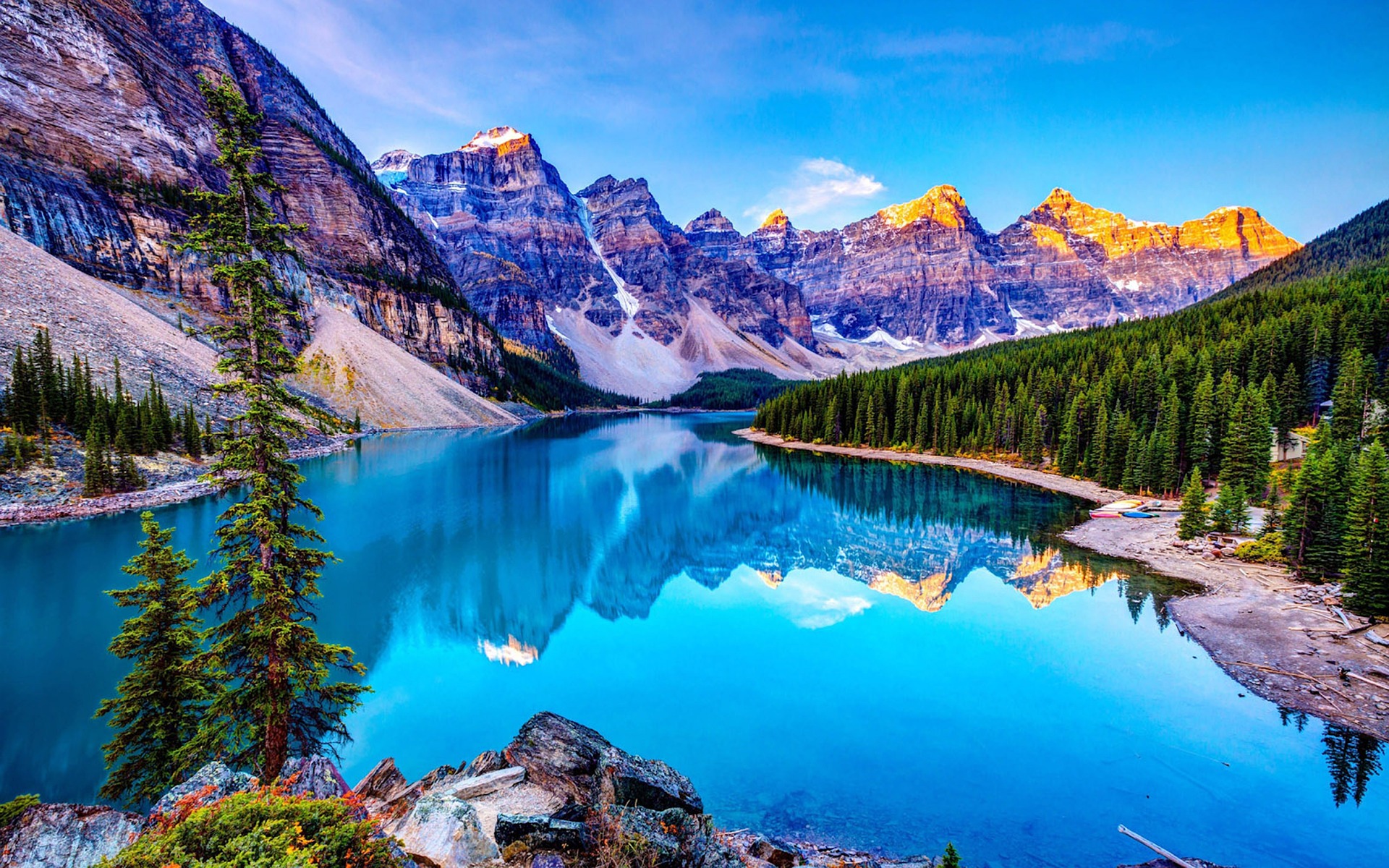AI Edition
Please check all the recent information about the attractions mentioned in this itinerary then plan the visit at your own pace.
If you have three days to spend in Banff National Park, Canada, here’s a suggested itinerary to make the most of your time. Some attractions may have changed due to natural circumstances, maintenance, or updated park regulations.
Day 1:
Start your day by visiting the Banff Visitor Centre in the town of Banff. The visitor center offers a wealth of information about Banff National Park, including maps, brochures, and guides. Knowledgeable staff members are available to answer your questions, provide recommendations, and offer suggestions based on your interests and the duration of your stay.
A National Park Pass is required when entering a national park in Canada. Banff National Park entry and service fees help support visitor services and facilities. Park Passes can be purchased online, at the park gates if driving to Banff National Park, or in person at the Visitor Centers in Banff and Lake Louise.
You can drive to Lake Minnewanka, the largest lake in Banff National Park. Take a scenic boat tour or hike along the lakeshore trail to enjoy stunning views.
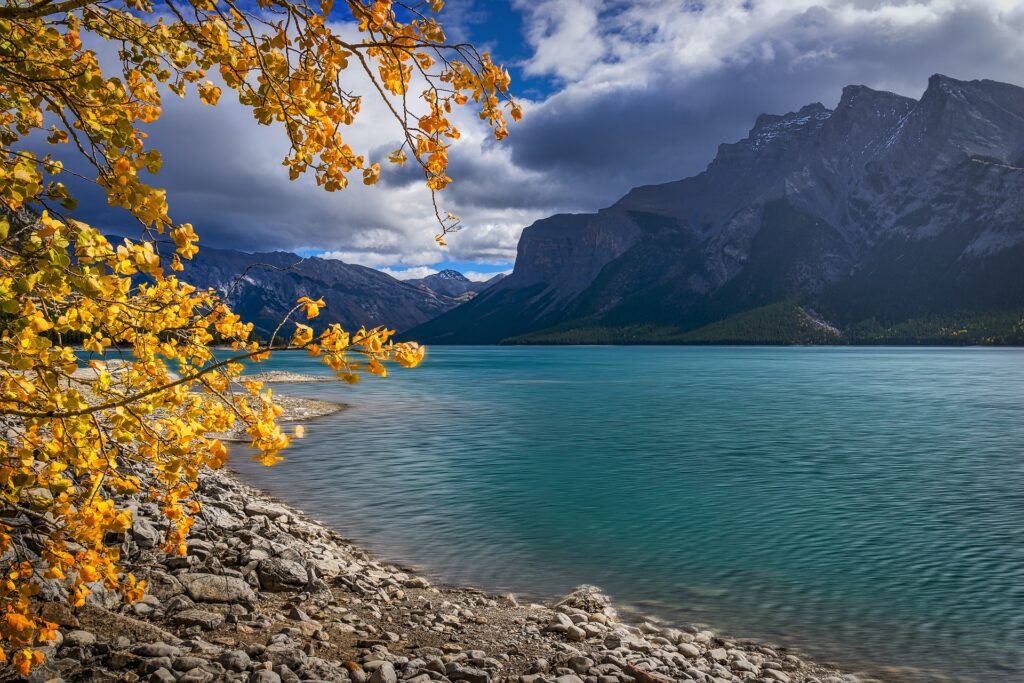
Image by Jörg Vieli from Pixabay
The lake is nestled amidst towering mountains, offering breathtaking views in every direction. The turquoise waters of Lake Minnewanka create a stunning contrast against the surrounding peaks, making it a photographer’s paradise.
One of the popular activities at Lake Minnewanka is taking a scenic boat tour. You can hop aboard a guided interpretive cruise that takes you across the lake while providing fascinating insights into the history, geology, and wildlife of the area. It’s a great way to learn about the region while enjoying the serene beauty of the lake.
Lake Minnewanka offers several hiking and biking trails for outdoor enthusiasts. The Lake Minnewanka Trail is a 21-kilometer (13-mile) loop that follows the lakeshore, providing opportunities for a leisurely walk or a bike ride. You can also explore nearby trails like the Stewart Canyon or Aylmer Pass trails for a more challenging adventure.
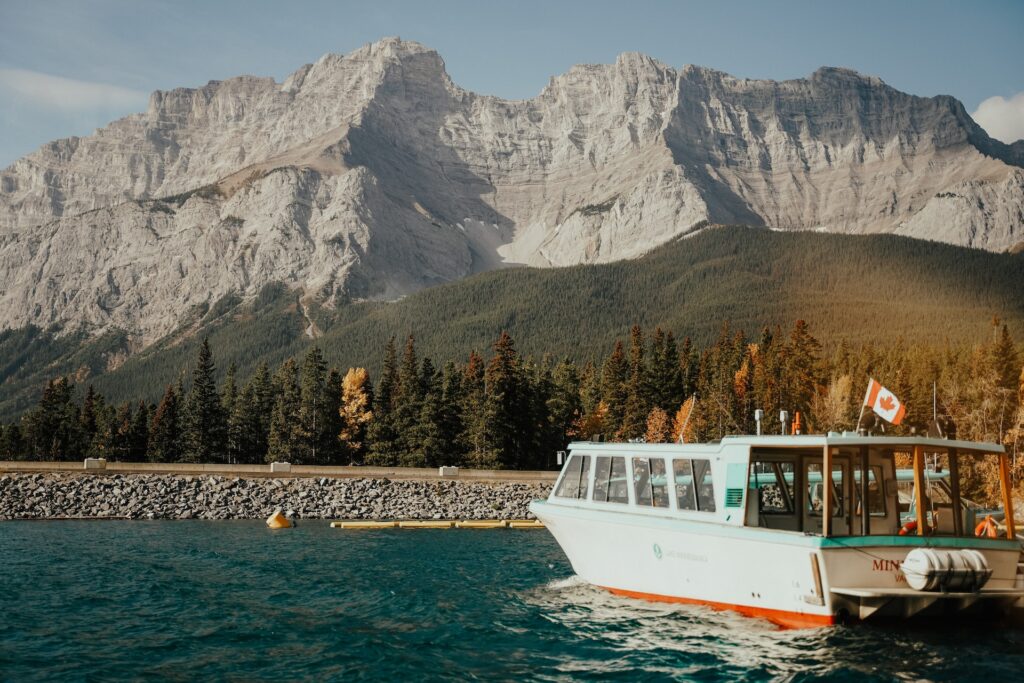
Photo by DA Capture
You can have other activities here such as fishing, picnicking, wildlife viewing, and scuba diving. Lake Minnewanka is located approximately 10 minutes of driving from the town of Banff, and there are parking facilities available near the lake. Remember to bring appropriate clothing, sunscreen, and insect repellent when visiting, and always respect the park’s guidelines for wildlife safety and environmental conservation.
In the afternoon, you can head to the Banff Gondola that provides visitors with a scenic ride to the top of Sulphur Mountain, offering panoramic views of the Canadian Rockies and the surrounding natural beauty.
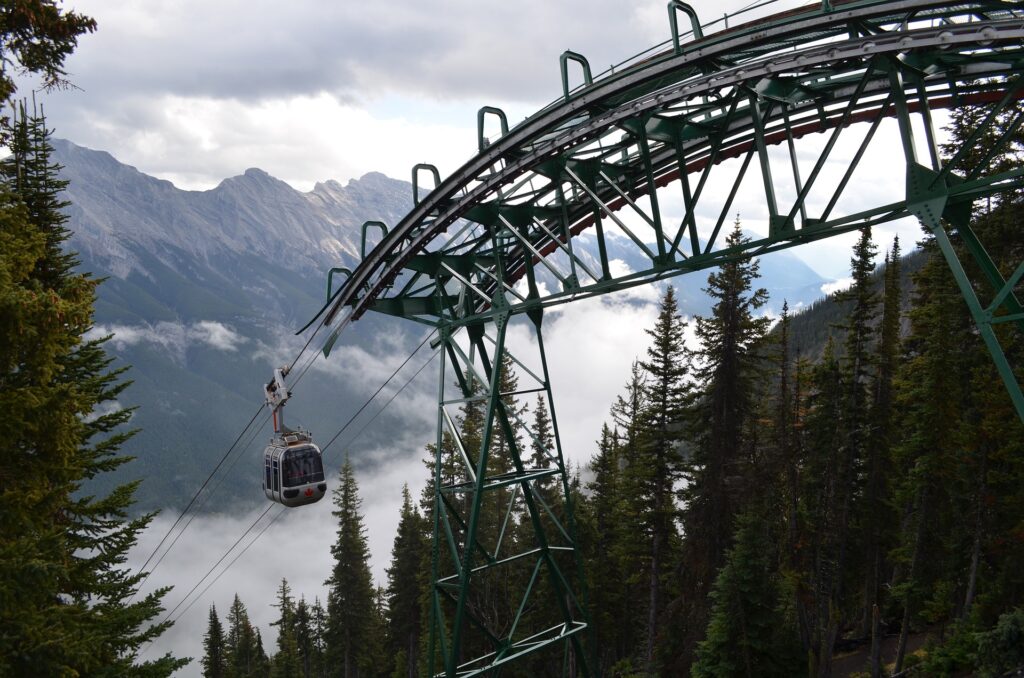
Image by alexsutcliffe from Pixabay
The Banff Gondola takes you on a picturesque eight-minute ride to the summit of Sulphur Mountain. The fully enclosed gondola cabins offer 360-degree views of the mountains, valleys, and forests as you ascend to an elevation of 2,281 meters (7,486 feet).
Once you reach the top, you’ll step out into a world of breathtaking vistas. There are multiple observation decks and boardwalks where you can admire the stunning panoramic views of Banff, the Bow Valley, and the surrounding mountain ranges. On a clear day, you may even see as far as the neighboring peaks of British Columbia.
Then you can drive to the picturesque Two Jack Lake and have a picnic lunch. You can also rent a canoe or kayak and explore the serene waters.
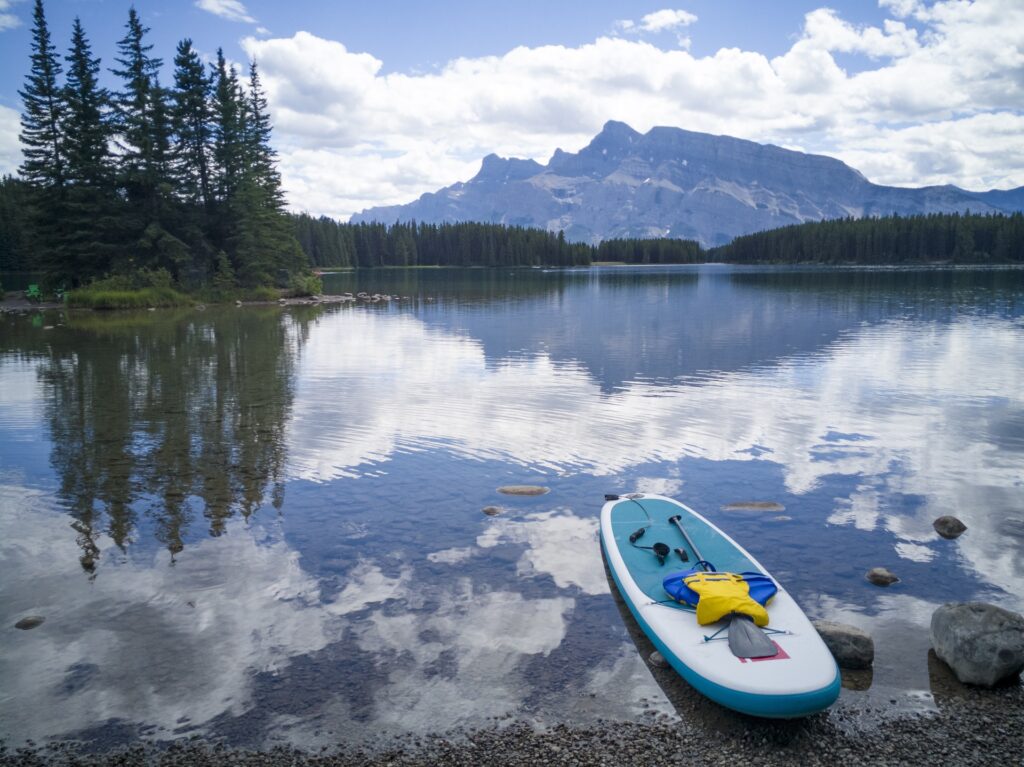
In the evening, you can drive to Vermilion Lakes, a series of interconnected lakes with beautiful reflections of the surrounding mountains. It’s an excellent spot for a leisurely stroll or a sunset photography session.

Image by Leona2013 from Pixabay
Return to Banff and enjoy dinner at one of the town’s many restaurants. Consider trying local specialties like elk or bison.
Day 2:
- Moraine Lake
- Lake Louise
- The Plain of Six Glaciers or the Lake Agnes Tea House
- Relaxing dinner at Lake Louise
Start early and drive to Moraine Lake, known for its stunning turquoise waters and surrounding peaks. Arriving early allows you to beat the crowds and take in the serene beauty of the lake.

Moraine Lake is a glacially-fed lake, 14 kilometers (8.7 miles) outside the Village of Lake Louise. It is situated in the Valley of the Ten Peaks, at an elevation of approximately 1,884 meters (6,181 feet). The lake, being glacially fed, does not reach its crest until mid to late June. When it is full, it reflects a distinctive shade of azure blue. The unique color is due to the refraction of light off the rock flour (fine particles of rock) deposited in the lake on a continual basis by surrounding glaciers.
The area around the lake has several walking/hiking trails which are, from time to time, restricted. The trail most commonly taken by tourists is The Rockpile Trail, which is along the actual moraine. The view of the lake from the top of the rockpile is one of the most photographed locations in all of Canada. That view of the mountains behind the lake in Valley of the Ten Peaks is known as the “Twenty Dollar View”, as Moraine Lake was featured on the reverse side of the 1969 and 1979 issues of the Canadian twenty dollar bill.
Aside from its aesthetic appeal, Moraine Lake is also popular for activities such as canoeing and hiking. However, please note that due to grizzly bears in the area, some trails may require hiking in tight groups for safety reasons.
The lake was accessible via a road that typically opens in late May and closes in mid-October, depending on the weather. But always check current conditions and restrictions before planning a visit.
After visiting Moraine Lake, drive to nearby Lake Louise. Take a stroll along the lakeshore trail and marvel at the iconic Fairmont Chateau Lake Louise.

The Fairmont Chateau Lake Louise is a luxury resort hotel located in Alberta, Canada’s Banff National Park, a UNESCO World Heritage Site. The hotel is situated on the eastern shore of Lake Louise, near the Victoria Glacier. Its stunning location, surrounded by snow-frosted Rocky Mountain peaks, secluded next to a legendary lake, makes it a popular tourist destination.
This iconic hotel was originally built at the end of the 19th century by the Canadian Pacific Railway, as a part of a series of hotels along its transcontinental railroad route through Canada. Since then, it has been expanded and renovated several times.
The Fairmont Chateau Lake Louise offers a wide range of luxury rooms and suites, many with breathtaking views of the surrounding mountains or Lake Louise. The hotel also features several dining options, from casual to fine dining, and wellness facilities including a spa and a fitness center. In addition, the hotel can arrange a variety of outdoor activities for guests, depending on the season, such as skiing, snowboarding, ice skating, hiking, canoeing, horseback riding, and more.
Whether you’re looking for a relaxing retreat in a beautiful natural setting, an active outdoor adventure, or a luxurious vacation with fine dining and spa treatments, the Fairmont Chateau Lake Louise offers a range of options to suit your needs.

Image by Amir Rasheed from Pixabay
Lake Louise is a beautiful turquoise, glacier-fed lake located in Banff National Park in the Canadian Rockies of Alberta, Canada. Named after Princess Louise Caroline Alberta, the fourth daughter of Queen Victoria, the lake is known for its stunningly beautiful setting and the iconic Fairmont Chateau Lake Louise hotel on its eastern shore.
The lake is surrounded by snow-capped peaks, and at the far end stands the impressive Victoria Glacier. The color of the water, a vibrant shade of turquoise, changes throughout the summer season as the glaciers melt. This color is a result of the light filtering into the rock flour (glacial silt) that flows into the lake.
Lake Louise is a major tourist destination and offers a variety of activities year-round. In summer, activities include hiking, canoeing, horseback riding, and rock climbing. The trails around the lake offer a range of hikes, from casual walks to more strenuous hikes up into the mountains. In winter, the area becomes a snowy wonderland and is popular for winter sports like downhill skiing and snowboarding at Lake Louise Ski Resort, ice-skating on the frozen lake, and cross-country skiing.
In the afternoon, you can embark on a hike to one of the many stunning alpine destinations in the area, such as the Plain of Six Glaciers or the Lake Agnes Tea House. These hikes offer breathtaking views of glaciers, mountains, and turquoise lakes.
In the evening, you can return to Lake Louise and have a relaxing dinner at one of the lakeside restaurants. If you have energy left, you can take an evening stroll around the lake or enjoy a drink at the Fairmont Chateau’s Lakeview Lounge.
Day 3:
- Icefields Parkway
- Walk on the Athabasca Glacier
- Columbia Icefield
- Glacier Skywalk
- Sunwapta Falls
- Jasper
The Icefields Parkway, also known as Highway 93 North, is a scenic road in Alberta, Canada. It spans 232 kilometers (144 miles) between Jasper National Park and Banff National Park, offering stunning views of the Canadian Rocky Mountains.
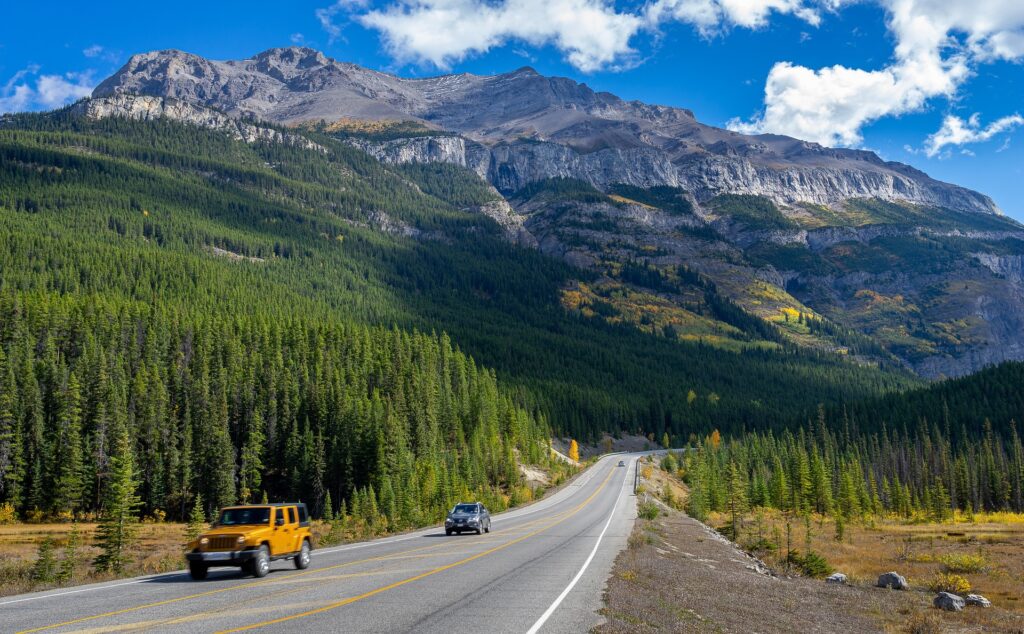
Image by Jörg Vieli from Pixabay
In the morning, you can drive along the Icefields Parkway that is named for the Columbia Icefield, one of the largest accumulations of ice and snow south of the Arctic Circle, which the parkway passes. Along the parkway, there are several significant glaciers visible from the road, including the Athabasca Glacier and the Dome Glacier.
In addition to glaciers, the Icefields Parkway offers views of turquoise-colored lakes, waterfalls, and high peaks. It is one of the most scenic drives in the world. Stop at viewpoints such as Peyto Lake and Bow Lake for awe-inspiring vistas. Other notable sites along the route include Sunwapta Falls and the Athabasca Falls. The parkway also passes through dense forests that are home to a variety of wildlife, such as elk, black bears, and mountain goats.
Despite the stunning natural beauty, it’s also a remote and rugged area. Services along the parkway are limited, especially in the winter months when weather conditions can be harsh. It’s recommended to check road conditions before embarking on a journey and to bring necessary supplies such as food, water, and a spare tire.
One of the most popular activities along the parkway is the Glacier Adventure tour, which provides an opportunity to walk on the Athabasca Glacier using a special all-terrain vehicle. There’s also a glass-bottomed Glacier Skywalk that offers a unique perspective on the landscape.
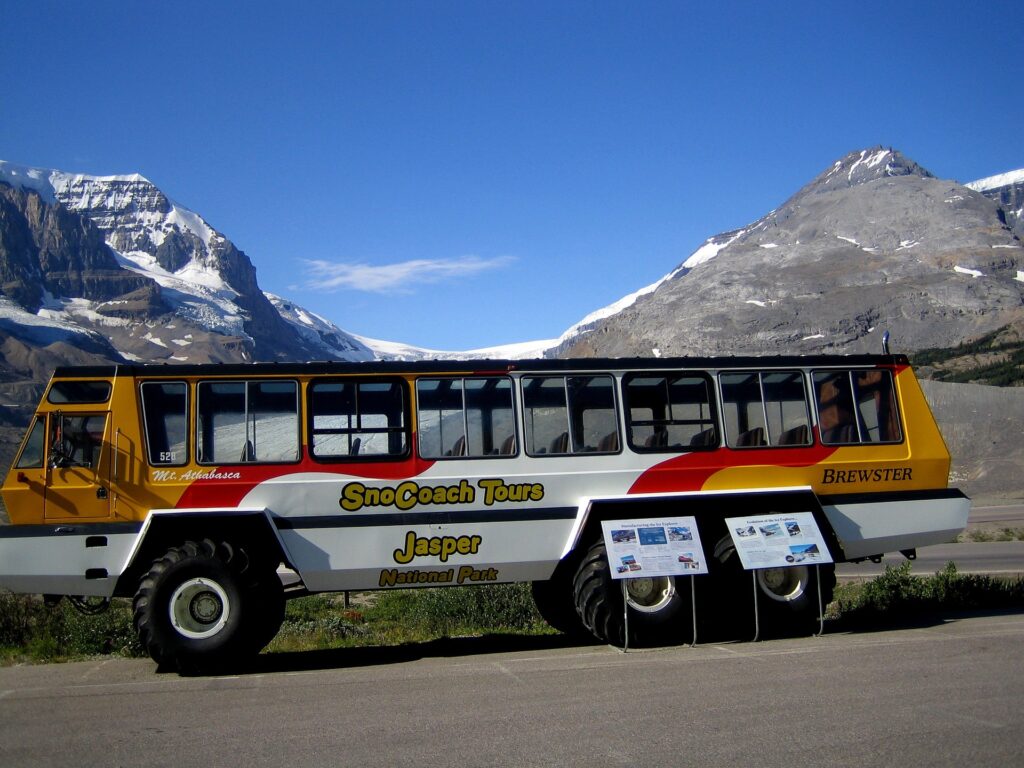
Image by Brigitte Werner from Pixabay
Overall, the Icefields Parkway is considered one of the most beautiful drives in the world and a must-visit for nature lovers and adventurers. It’s a fantastic place to experience the majesty of the Canadian Rockies.
The Columbia Icefield is a surviving remnant of the thick ice mass that once covered most of Canada’s mountains. Located in the Canadian Rockies, it straddles the Continental Divide along the border of British Columbia and Alberta. The icefield lies partly in the northwestern tip of Banff National Park and the southern end of Jasper National Park.

Image by Jackie Burton from Pixabay
Covering an area of about 325 square kilometers, with depths up to 365 meters (1,200 feet), the Columbia Icefield is the largest icefield in the Rocky Mountains. It feeds eight major glaciers, including the Athabasca, Dome, and Stutfield Glaciers, among others.
The Columbia Icefield is a significant source of fresh water, feeding rivers that eventually flow into three different oceans – the Atlantic, Pacific, and Arctic – making it a crucial hydrological hub.
This area is a popular tourist destination, especially the Athabasca Glacier, which is the most visited glacier in North America. Visitors can experience the icefield through the Ice Explorer snow coach tours, which take them directly onto the surface of the Athabasca Glacier. Another popular attraction is the Glacier Skywalk, a glass-floored observation platform over the Sunwapta Valley offering a unique perspective on nature’s grandeur.
However, like many glaciers and icefields worldwide, the Columbia Icefield is rapidly retreating due to climate change. Research shows that it has been losing ice since the mid-19th century and the rate of loss has increased in recent decades. If the current rates of climate change persist, it’s predicted that the icefield could lose 90% of its volume by the end of this century. This potential loss is not only a concern for the local ecosystem but also for water supplies in the region.
In the afternoon, you can continue drive on the Icefields Parkway and make stops at the Glacier Skywalk and Sunwapta Falls to appreciate more of the region’s natural beauty.
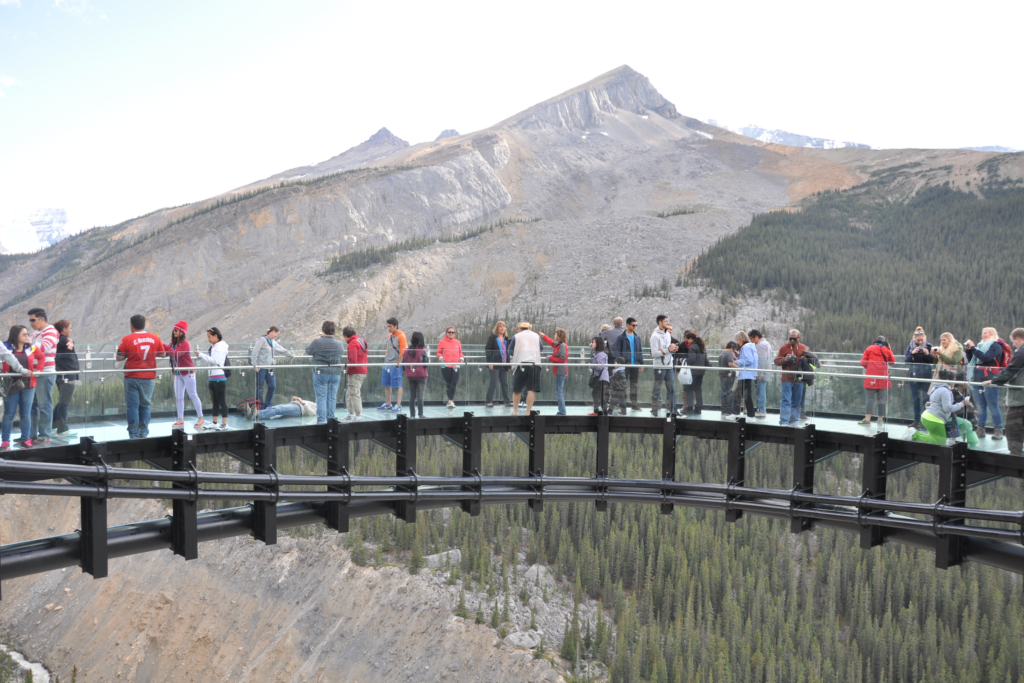
Glacier Skywalk Photo by Bobby Mc Gee Lee
The Glacier Skywalk is an attraction near the Columbia Icefield in Jasper National Park. Opened in 2014, it is a cliff-edge walkway that leads to a glass-floored observation platform 280 meters (918 feet) over stunning glacier-formed valleys and rushing waterfalls.
Visitors are able to experience a bird’s eye view of the Sunwapta Valley below, and interpretive displays along the walk provide information about the unique ecosystem and the geology of the area.
It’s important to note that the Glacier Skywalk does not actually provide views of any glaciers, despite its name. For that, visitors will want to visit the nearby Columbia Icefield or Athabasca Glacier. Nevertheless, the Glacier Skywalk is a popular destination for its breathtaking views and unique construction.
Sunwapta Falls is a pair of stunning waterfalls located in the Jasper National Park. The name “Sunwapta” means “turbulent river” in the native language of the Stoney people, which is an apt description of this powerful and scenic waterfall.
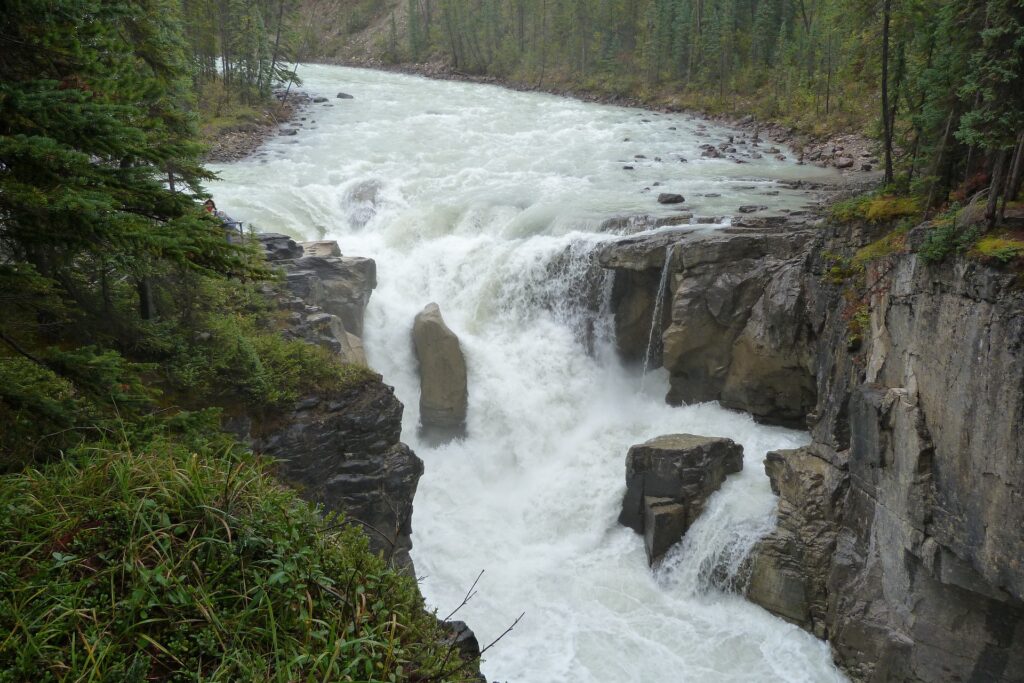
Sunwapta Falls Image by Peter from Pixabay
Sunwapta Falls is located along the Icefields Parkway, about 55 kilometers (34 miles) south of the Jasper townsite. The falls are fed by the Athabasca Glacier, and thus, its flow varies with the glacial melt, typically peaking in the late spring and early summer.
The falls consist of an upper and lower waterfall. The upper falls are easily accessible from the road, dropping about 18.5 meters (60 feet), and are most often the ones pictured in photographs. A short trail leads to the viewing area for these falls. The lower falls, which are a series of cascades dropping a total of about 45.7 meters (150 feet), are a short hike downstream from the upper falls.
If time permits, visit Jasper. Enjoy a walk through the town, visit local shops, and have some drinks or food.
Jasper is a charming town. Known for its stunning mountain scenery, abundant wildlife, and outdoor adventure opportunities, Jasper is a popular destination for nature lovers and outdoor enthusiasts. Here’s an overview of what you can expect when visiting Jasper:
- Outdoor Activities: Jasper National Park offers a wide range of outdoor activities for all skill levels. You can go hiking on numerous trails, ranging from easy strolls to challenging multi-day treks. Some popular hiking destinations include the Maligne Canyon, Bald Hills, and Valley of the Five Lakes. Other activities include mountain biking, wildlife watching, fishing, canoeing or kayaking on pristine lakes, and horseback riding.
- Maligne Lake: Maligne Lake is one of the most picturesque spots in Jasper. Take a scenic boat cruise to Spirit Island, a small island with a cluster of pine trees surrounded by turquoise waters. The boat tour offers breathtaking views of the surrounding mountains and glaciers.
- Athabasca Falls: Located just outside of Jasper, Athabasca Falls is a powerful waterfall on the Athabasca River. There are paved walking paths and viewing platforms that provide excellent vantage points to witness the force and beauty of the falls.
- Jasper SkyTram: Experience the Jasper SkyTram, a cable car that takes you up Whistlers Mountain. From the summit, you’ll enjoy panoramic views of the town of Jasper, the surrounding valleys, and the Canadian Rockies. There are hiking trails at the top for further exploration.
- Wildlife Viewing: Jasper National Park is home to an abundance of wildlife, including bears, elk, bighorn sheep, moose, and mountain goats. Keep your eyes peeled while exploring the park, and you may be lucky enough to spot some of these incredible creatures. However, always remember to maintain a safe distance and observe wildlife from a respectful distance.
- Jasper Townsite: The town of Jasper itself offers a variety of amenities, including accommodations, restaurants, cafes, shops, and art galleries. Take a leisurely stroll through the townsite, enjoy local cuisine, and browse for souvenirs or locally made crafts.
Jasper offers a memorable experience with its natural beauty and outdoor activities.
In the evening, start your return journey to Banff and enjoy the scenic drive back. Take your time to make additional stops along the way if there are any viewpoints or attractions you missed on the journey up.
Arrive in Banff and spend your final evening exploring the town’s lively atmosphere. You can visit local shops, dine at a restaurant, or simply relax and enjoy the mountain views.
Remember to check the weather and trail conditions before setting out on any hikes and make sure to pack appropriate clothing and gear for outdoor activities. Enjoy your time in Banff National Park!
